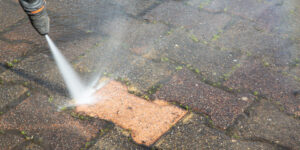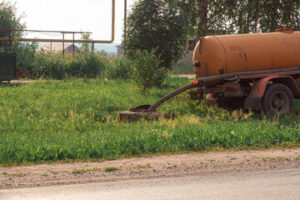
Pressure Washing, also known as power washing is a safe and effective method of cleaning surfaces such as dirt, mud, grime, salt, mildew, mold, chewing gum and other contaminants. A pressure washer (or power cleaner) uses an electric motor or gas engine to drive a water pump that is connected to a high-pressure hose. Read on Pressure Washing Near Me for more details.
Detergents
The power of a pressure washer can make short work of tough-to-remove grime, dirt, mold and mildew that can degrade surfaces. However, sometimes the simplest and most economical way to clean a surface is to use hot water mixed with soap detergent. This is why you see professional pressure cleaning services using commercial grade chemicals and detergents to clean industrial equipment, vehicles and buildings. Pressure washing with the right detergents can dramatically speed up cleaning time and improve the results of your cleaning job.
There are many different types of pressure washer detergents, soaps and cleaners available, each formulated for specific types of surfaces. Using the correct cleaning chemicals will help you achieve the best results and keep your pressure washer in top working condition.
For example, you would use a degreaser to get rid of oily messes and a rust remover for metal surfaces like cars and tools. There are also a number of different cleaning solutions for concrete, masonry, trex and wood decking, vinyl siding, fences, awnings and pools. Some solutions contain acids such as citric, hydrochloric and oxalic for removing stains, while others are designed to be safe on plants and wood.
You can find pressure washer detergent, soap and cleaners at your local hardware store or at online suppliers. Just be sure to read the label and choose a solution that is safe for your particular surface as well as your machine. Typically, you will want to stay away from bleach, chlorine and other corrosives as they can damage your machinery.
In addition to enhancing the performance of your pressure washer, a good detergent will also protect your surfaces from damage and help you complete your cleaning project faster. For instance, Hotsy’s line of biodegradable detergents and cleaners contain additives that prevent soap and hard-water build up in your pressure washer system components and pipes. This extends the life of your machine and reduces maintenance costs.
Before you begin, take a look at your cleaning task and scan the area for any shrubs or flowers that could be damaged by your high-pressure spray. Then cover or move them away from the cleaning area. You should also cover any furniture or items in the vicinity of your surface and protect yourself from the splash back from your water spray with a tarp or plastic tablecloth. Once your surface is ready to be cleaned, set the nozzle on your pressure washer to a lower psi than usual and apply your chemical or cleaning solution in a bottom-to-top direction.
Pressure
Pressure Washing is a cleaning technique that uses high-pressure water to remove dirt, mold, mildew, grease, oil and other unwanted substances from outdoor surfaces, such as decks, patios, siding, roofs, driveways and other exterior areas of buildings and homes. It can also be used to clean automobiles, boats, airplanes and other types of equipment. Pressure washing is a fast and effective way to get rid of built-up dirt, grime, mildew and other contaminants. It can also be used to remove paint and other surface coatings.
The process of pressure washing involves using a machine that generates a powerful stream of water under high-pressure. The machine has a water pump, which is powered by an electric motor or gas engine. The pump accelerates the water, which is then delivered through a specialty hose to a spray nozzle. The nozzle can be adjusted to control the flow of water and adjust the pressure.
A water filter prevents debris from entering the system, ensuring that only clean water is delivered to the surface being cleaned. The pressure washer is designed to reach into crevices and hard-to-reach places, providing a deep clean and removing stubborn stains. Pressure washing is a time-saving and cost-effective alternative to traditional cleaning methods, such as scrubbing.
Although pressure washing is effective on a variety of surfaces, it can cause damage to certain materials if the pressure settings are too high. It is important to hire a professional with experience and knowledge of the proper techniques and pressure settings for each surface type to avoid damage.
Brick is an attractive and durable material for building homes and other structures, but it can become dirty and mossy over time. Regular cleaning is needed to maintain its appearance and keep it safe from structural damage. The best method for cleaning brick is to use a pressure washer with the proper settings. A professional will know the correct water temperature, pressure and detergent to use for each surface.
If you are interested in learning more about how a Mi-T-M pressure washer can help you clean and restore your home, business or automobile, contact us today! Our experts will be happy to answer any questions you may have.
Temperature
While this may seem like a minor factor, the temperature of the water used in pressure washing does help. During the pressure washing process, the hot water breaks down oil and grease molecules on surfaces. This allows the detergents to emulsify them and wash them away. The temperature of the water also helps to loosen dirt and grime, making it easier to remove from surfaces.
Water enters a pressure washer from the spigot or tank via a garden hose and passes through a pump that speeds it up and sends it through a heating coil, made of up to 200 ft. of half-inch, schedule 80 steel pipe or tubing (for gas and electric models).
The ideal time to pressure wash is between March and November when outdoor temperatures are warm and there is less chance of the water freezing on the surfaces being cleaned.
Water
Pressure Washing is the process of using specialized equipment to blast off dirt, mold, mildew, and other impurities from various surfaces. The high-powered water stream can reach into crevices and hard-to-reach areas, ensuring a thorough and effective cleaning. This method is often used to clean outdoor spaces, such as driveways and sidewalks. It is also useful for removing stubborn stains and organic build-up from exterior walls, roofs, and decks.
The power of the water used in pressure washing is what makes it so effective. It is often hot, which helps to break down grime and dirt. The force of the water is also what allows it to penetrate deep into surface pores, breaking down and dissolving the contaminants.
Aside from the heat, the hot water used in pressure washing is also helpful because it aids in the removal of sticky substances like grease and oil. In addition, the temperature of the water helps to increase the kinetic energy of the water spray, which is necessary for removing stubborn stains.
Unlike a garden hose, which is typically attached to a low-pressure pump, a professional pressure washer uses an electric or gas-powered motor to power a special pump that increases the water flow. This water is then fed through a hose and accelerated to produce a high-pressure spray. This spray is then directed through a variety of nozzles to target different areas of the surface being cleaned.
While it is possible to DIY pressure washing, this can be extremely dangerous. Highly pressurized water can damage home siding, wood decks, and other structures if the pressure is too great.
It is also important to understand the different settings on a pressure washer before trying to use it yourself. A professional will have the training and experience to know when to increase or decrease the water pressure. Inexperienced users can easily over- or under-water their cleaning projects, which can lead to costly repairs and damage.
In addition to being able to clean tough stains and organic build-up, professional pressure washing services can help restore the appearance of a property and increase its value. They can also help prevent rot and other problems caused by dirt, mildew, and mold.

